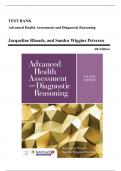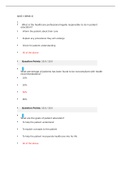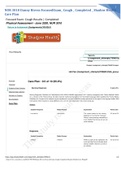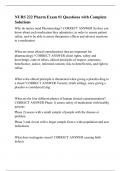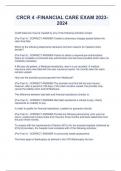TEST BANK
Advanced Health Assessment and Diagnostic Reasoning
Jacqueline Rhoads, and Sandra Wiggins Petersen
4th Edition
,Table of Contents
Chapter 01 Interview and History-Taking Strategies 1
Chapter 02 Physical Examination Strategies 7
Chapter 03 Documentation Strategies 13
Chapter 04 Cultural and Spiritual Assessment 19
Chapter 05 Nutritional Assessment 22
Chapter 06 Mental Health Disorders 25
Chapter 07 Integumentary Disorders 31
Chapter 08 Eye Disorders 37
Chapter 09 Ear Disorders 43
Chapter 10 Nose, Sinus, Mouth, and Throat Disorders 49
Chapter 11 Respiratory Disorders 55
Chapter 12 Cardiovascular Disorders 61
Chapter 13 Endocrine Disorders 67
Chapter 14 Gastrointestinal Disorders 73
Chapter 15 Neurological Disorders 79
Chapter 16 Male Genitourinary Disorders 85
Chapter 17 Female Genitourinary and Breast Disorders 91
Chapter 18 Musculoskeletal Disorders 96
Midterm Exam 102
Final Exam 126
Instructor Resource Guide 149
Title Page 149
Jones & Bartlett Learning 150
For Instructors Who Are Teaching Completely Online Courses 150
Advanced Health Assessment and Diagnostic Reasoning 151
Course Items and Supplemental Material 152
Chapter 1: Interview and History Taking Strategies 153
Chapter 2: Physical Examination Strategies 156
Chapter 3: Documentation Strategies 159
Chapter 4: Cultural and Spiritual Assessment 163
Chapter 5: Nutritional Assessment 167
Chapter 6: Mental Health Disorders 171
Chapter 7: Integumentary Disorders 174
Chapter 8: Eye Disorders 177
Chapter 9: Ear Disorders 181
Chapter 10: Nose, Sinus, Mouth, and Throat Disorders 184
Chapter 11: Respiratory Disorders 187
Chapter 12: Cardiovascular Disorders 191
Chapter 13: Endocrine Disorders 195
Chapter 14: Gastrointestinal Disorders 198
Chapter 15: Neurological Disorders 202
,Chapter 16: Male Genitourinary Disorders 205
Chapter 17: Female Genitourinary and Breast Disorders 208
Chapter 18: Musculoskeletal Disorders 211
, WWW.
______________________________________________________________________________________________
Test Bank - Advanced Health Assessment and Diagnostic Reasoning, 4th Edition (Rhoads, 2021)
Advanced Health Assessment and Diagnostic Reasoning, Fourth Edition
Test Bank
Import Settings:
Base Settings: Brownstone Default
Information Field: Complexity
Information Field: Ahead
Information Field: Subject
Information Field: Advanced Health Assessment and Diagnostic Reasoning
Information Field: Taxonomy
Highest Answer Letter: D
Multiple Keywords in Same Paragraph: No
NAS ISBN13: 9781284171228, add to Ahead, Title tags
Chapter: Chapter 01 Interview and History-Taking Strategies
Multiple Choice
1. Which of the following is an example of subjective data that may be collected during a health
assessment?
A) Height and weight
B) A patient’s recall of his or her past health conditions
C) Results from an abdominal CT scan
D) Complete blood count
Ans: B
Complexity: Moderate
Ahead: Functions of the Interview and Health History
Subject: Chapter 1
Title: Interview and History-Taking Strategies
Taxonomy: Application
2. Which of the following is true regarding the data taken in a health history?
A) Most health history data are objective and measurable.
B) Objective data are error-free, quantifiable data.
C) Subjective data, being inherently less accurate, are of less value than objective data.
D) A successful individualized plan of care must incorporate subjective data.
Ans: D
Complexity: Difficult
Ahead: Functions of the Interview and Health History
Subject: Chapter 1
Title: Interview and History-Taking Strategies
Taxonomy: Analysis
3. What do Coulehan and Block define as “listening to the total communication . . . and letting the patient
know that you are really hearing”?
A) Cultural competence
B) Patience
C) Empathy
D) Top-tier communication
______________________________________________________________________________________________
1|Page
, WWW.
______________________________________________________________________________________________
Test Bank - Advanced Health Assessment and Diagnostic Reasoning, 4th Edition (Rhoads, 2021)
Advanced Health Assessment and Diagnostic Reasoning, Fourth Edition
Test Bank
Ans: C
Complexity: Moderate
Ahead: Interviewing
Subject: Chapter 1
Title: Interview and History-Taking Strategies
Taxonomy: Recall
4. The provider is preparing to take a health history for a new patient. He takes the patient to a private
room and asks the patient to don a hospital gown. After stepping outside to give the patient sufficient time
to change, he then comes back in and asks permission to conduct the history. He sits next to the patient
at eye level, discreetly observes the patient for any sensory deficits, and asks the patient if he may take
brief notes of the conversation. During the conversation, he gives the patient time to answer questions
fully. He makes sure that his questions do not contain technical terms and quietly observes the patient’s
nonverbal behaviors throughout. Which mistake did the provider make?
A) He should have allowed the patient to remain fully clothed in their own clothing for their comfort.
B) He should not have omitted technical terminology. Patients like having a chance to learn.
C) He should have seated himself slightly above eye level to give the patient nonverbal reassurance of
his experience and professionalism.
D) He should have asked explicitly about the nonverbal changes he was noticing in order to gain a
deeper level of understanding of the patient’s current condition.
Ans: A
Complexity: Difficult
Ahead: Taking a Health History
Subject: Chapter 1
Title: Interview and History-Taking Strategies
Taxonomy: Analysis
5. Which of the following is true of both comprehensive and focused health histories?
A) They both include identifying data.
B) They both include a social history.
C) They both include a family history.
D) They are both conducted in emergency situations.
Ans: A
Complexity: Moderate
Ahead: Taking a Health History
Subject: Chapter 1
Title: Interview and History-Taking Strategies
Taxonomy: Application
6. In the mnemonic devise PQRST, which of the following includes describing the location of the
symptoms?
A) Precipitating factors
B) Quality
C) Radiation
D) Severity
Ans: B
Complexity: Difficult
Ahead: Taking a Health History
Subject: Chapter 1
Title: Interview and History-Taking Strategies
______________________________________________________________________________________________
2|Page
, WWW.
______________________________________________________________________________________________
Test Bank - Advanced Health Assessment and Diagnostic Reasoning, 4th Edition (Rhoads, 2021)
Advanced Health Assessment and Diagnostic Reasoning, Fourth Edition
Test Bank
Taxonomy: Analysis
7. What is the current mnemonic device for taking a health history?
A) PQRST
B) CLIENT OUTCOMES
C) PRACTICE
D) GOOD MEDICINE
Ans: B
Complexity: Easy
Ahead: Taking a Health History
Subject: Chapter 1
Title: Interview and History-Taking Strategies
Taxonomy: Recall
8. When taking a PMI, which of the following is correct?
A) Do not take the statement “I’m allergic to. . . ” at face value.
B) Ask the patient for a very brief summary of their current health.
C) If a patient states that they have been vaccinated with BCG, make sure to administer a PPD test.
D) CAM documentation is no longer a requirement.
Ans: A
Complexity: Difficult
Ahead: Taking a Health History
Subject: Chapter 1
Title: Interview and History-Taking Strategies
Taxonomy: Remember
9. Which of the following is a first-degree relative to the patient who has experienced premature onset of
CVD?
A) Sister at 62
B) Cousin at 62
C) Aunt at 59
D) Grandfather at 44
Ans: A
Complexity: Difficult
Ahead: Taking a Health History
Subject: Chapter 1
Title: Interview and History-Taking Strategies
Taxonomy: Analysis
10. Recording the patient’s occupation falls under which category?
A) PHI
B) FH
C) SH
D) ROS
Ans: C
Complexity: Easy
Ahead: Taking a Health History
Subject: Chapter 1
______________________________________________________________________________________________
3|Page
, WWW.
______________________________________________________________________________________________
Test Bank - Advanced Health Assessment and Diagnostic Reasoning, 4th Edition (Rhoads, 2021)
Advanced Health Assessment and Diagnostic Reasoning, Fourth Edition
Test Bank
Title: Interview and History-Taking Strategies
Taxonomy: Recall
11. A focused ROS:
A) involves a wider range and shallower level of questions than a comprehensive ROS.
B) includes questions directed toward the systems most likely to be involved in the patient’s symptoms.
C) includes questions seeking significant positives to narrow down the body systems affected.
D) covers all body systems.
Ans: B
Complexity: Moderate
Ahead: Taking a Health History
Subject: Chapter 1
Title: Interview and History-Taking Strategies
Taxonomy: Application
12. A patient comes to the clinic complaining of repeated headaches and lightheadedness. As the
provider takes a health history, he or she should:
A) perform a comprehensive ROS.
B) skip the social history in order to focus on the current issue.
C) focus her interest and questions on the patient’s neurologic system.
D) spend a good deal of time assessing the reliability of the information she is getting.
Ans: C
Complexity: Difficult
Ahead: Taking a Health History
Subject: Chapter 1
Title: Interview and History-Taking Strategies
Taxonomy: Analysis
True/False
1. True or False? A patient’s recall of his or her current health needs and past health is subject to error
and is also a critical component in the caregiving process.
Ans: True
Complexity: Moderate
Ahead: Functions of the Interview and Health History
Subject: Chapter 1
Title: Interview and History-Taking Strategies
Taxonomy: Recall
2. True or False? Ethnocentrism, belief in the superiority of one’s own beliefs and values, is a major
barrier to establishing effective patient–provider relationships.
Ans: True
Complexity: Easy
Ahead: Interviewing
Subject: Chapter 1
Title: Interview and History-Taking Strategies
______________________________________________________________________________________________
4|Page
, WWW.
______________________________________________________________________________________________
Test Bank - Advanced Health Assessment and Diagnostic Reasoning, 4th Edition (Rhoads, 2021)
Advanced Health Assessment and Diagnostic Reasoning, Fourth Edition
Test Bank
Taxonomy: Recall
3. True or False? A 58-year-old man at risk of diabetes, with a sedentary lifestyle and unhealthy diet, is
unwilling to follow his provider’s recommendations to modify his routine. Because he has not yet
experienced the negative health consequences of his actions, he cannot be classified as resistant.
Ans: False
Complexity: Moderate
Ahead: Interviewing
Subject: Chapter 1
Title: Interview and History-Taking Strategies
Taxonomy: Application
4. True or False? When taking a patient’s chief complaint, rephrase the stated reason using standard
medical terminology for clarity.
Ans: False
Complexity: Easy
Ahead: Taking a Health History
Subject: Chapter 1
Title: Interview and History-Taking Strategies
Taxonomy: Recall
5. True or False? Family history should include both parents and grandparents, if information is known.
Ans: True
Complexity: Moderate
Ahead: Taking a Health History
Subject: Chapter 1
Title: Interview and History-Taking Strategies
Taxonomy: Application
6. True or False? Social history includes a detailed diet history, best performed as a record of food and
beverage intake by the patient for a typical week, that includes things like use of salt and oil in food
preparation and methods of cooking.
Ans: True
Complexity: Moderate
Ahead: Taking a Health History
Subject: Chapter 1
Title: Interview and History-Taking Strategies
Taxonomy: Application
Essay
1. What does PQRST stand for?
Ans: Precipitating factors, quality, radiation, severity, and timing
Complexity: Difficult
______________________________________________________________________________________________
5|Page

